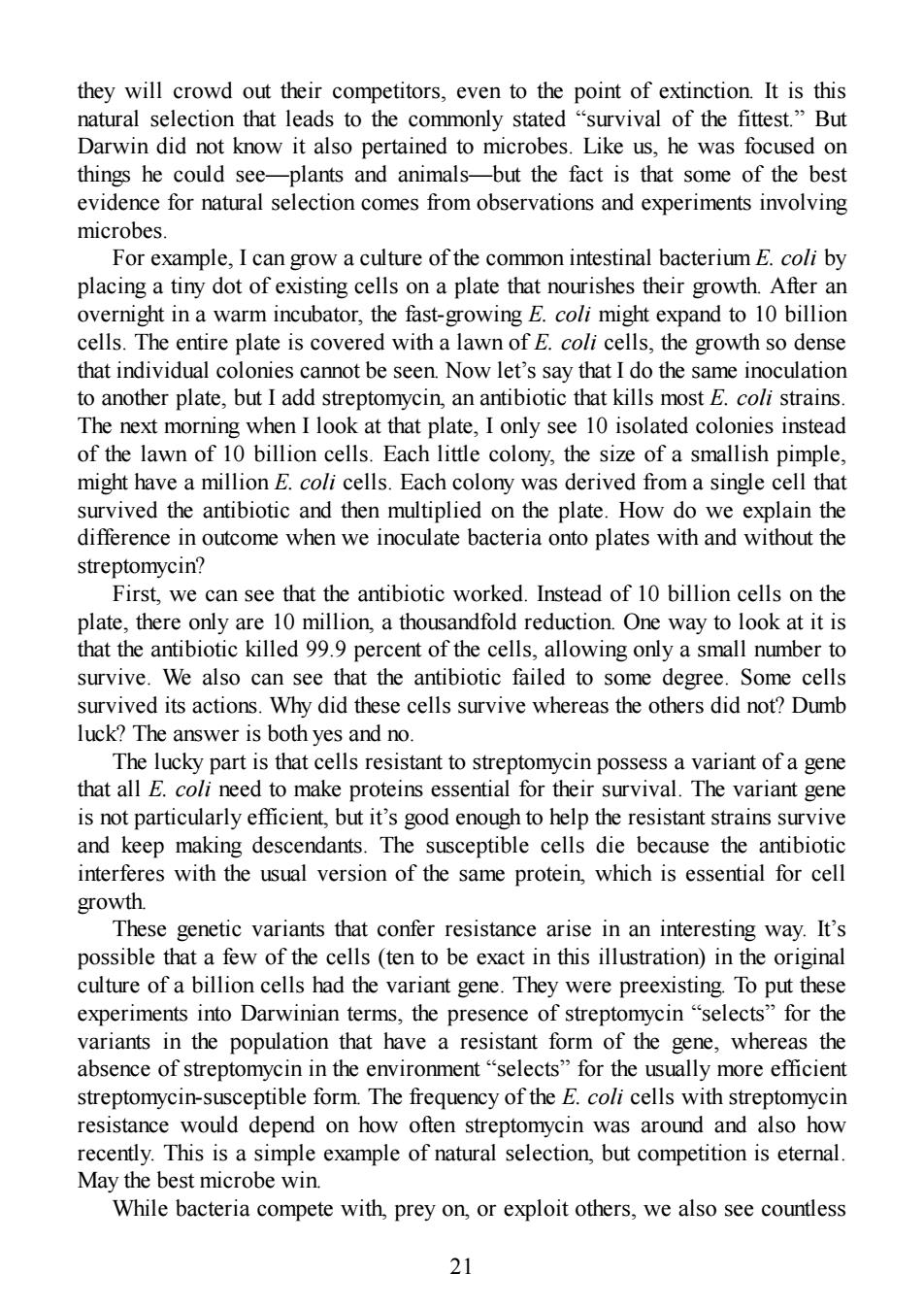正在加载图片...

they will crowd out their competitors,even to the point of extinction.It is this natural selection that leads to the commonly stated I“survival of the fittest.”But Darwin did not know it also pertained to microbes.Like us,he was focused on things he could see-plants and animals-but the fact is that some of the best evidence for natural selection comes from observations and experiments involving microbes. For example,I can grow a culture of the common intestinal bacterium E.coli by placing a tiny dot of existing cells on a plate that nourishes their growth.After an overnight in a warm incubator,the fast-growing E.coli might expand to 10 billion cells.The entire plate is covered with a lawn of E.coli cells,the growth so dense that individual colonies cannot be seen.Now let's say that I do the same inoculation to another plate,but I add streptomycin,an antibiotic that kills most E.coli strains The next morning when I look at that plate,I only see 10 isolated colonies instead of the lawn of 10 billion cells.Each little colony,the size of a smallish pimple, might have a million E.coli cells.Each colony was derived from a single cell that survived the antibiotic and then multiplied on the plate.How do we explain the difference in outcome when we inoculate bacteria onto plates with and without the streptomycin? First,we can see that the antibiotic worked.Instead of 10 billion cells on the plate,there only are 10 million,a thousandfold reduction.One way to look at it is that the antibiotic killed 99.9 percent of the cells,allowing only a small number to survive.We also can see that the antibiotic failed to some degree.Some cells survived its actions.Why did these cells survive whereas the others did not?Dumb luck?The answer is both yes and no. The lucky part is that cells resistant to streptomycin possess a variant of a gene that all E.coli need to make proteins essential for their survival.The variant gene is not particularly efficient,but it's good enough to help the resistant strains survive and keep making descendants.The susceptible cells die because the antibiotic interferes with the usual version of the same protein,which is essential for cell growth. These genetic variants that confer resistance arise in an interesting way.It's possible that a few of the cells(ten to be exact in this illustration)in the original culture of a billion cells had the variant gene.They were preexisting To put these experiments into Darwinian terms,the presence of streptomycin "selects"for the variants in the population that have a resistant form of the gene,whereas the absence of streptomycin in the environment"selects"for the usually more efficient streptomycin-susceptible form.The frequency of the E.coli cells with streptomycin resistance would depend on how often streptomycin was around and also how recently.This is a simple example of natural selection,but competition is eternal May the best microbe win. While bacteria compete with,prey on,or exploit others,we also see countless 31 they will crowd out their competitors, even to the point of extinction. It is this natural selection that leads to the commonly stated “survival of the fittest.” But Darwin did not know it also pertained to microbes. Like us, he was focused on things he could see—plants and animals—but the fact is that some of the best evidence for natural selection comes from observations and experiments involving microbes. For example, I can grow a culture of the common intestinal bacterium E. coli by placing a tiny dot of existing cells on a plate that nourishes their growth. After an overnight in a warm incubator, the fast-growing E. coli might expand to 10 billion cells. The entire plate is covered with a lawn of E. coli cells, the growth so dense that individual colonies cannot be seen. Now let’s say that I do the same inoculation to another plate, but I add streptomycin, an antibiotic that kills most E. coli strains. The next morning when I look at that plate, I only see 10 isolated colonies instead of the lawn of 10 billion cells. Each little colony, the size of a smallish pimple, might have a million E. coli cells. Each colony was derived from a single cell that survived the antibiotic and then multiplied on the plate. How do we explain the difference in outcome when we inoculate bacteria onto plates with and without the streptomycin? First, we can see that the antibiotic worked. Instead of 10 billion cells on the plate, there only are 10 million, a thousandfold reduction. One way to look at it is that the antibiotic killed 99.9 percent of the cells, allowing only a small number to survive. We also can see that the antibiotic failed to some degree. Some cells survived its actions. Why did these cells survive whereas the others did not? Dumb luck? The answer is both yes and no. The lucky part is that cells resistant to streptomycin possess a variant of a gene that all E. coli need to make proteins essential for their survival. The variant gene is not particularly efficient, but it’s good enough to help the resistant strains survive and keep making descendants. The susceptible cells die because the antibiotic interferes with the usual version of the same protein, which is essential for cell growth. These genetic variants that confer resistance arise in an interesting way. It’s possible that a few of the cells (ten to be exact in this illustration) in the original culture of a billion cells had the variant gene. They were preexisting. To put these experiments into Darwinian terms, the presence of streptomycin “selects” for the variants in the population that have a resistant form of the gene, whereas the absence of streptomycin in the environment “selects” for the usually more efficient streptomycin-susceptible form. The frequency of the E. coli cells with streptomycin resistance would depend on how often streptomycin was around and also how recently. This is a simple example of natural selection, but competition is eternal. May the best microbe win. While bacteria compete with, prey on, or exploit others, we also see countless 21